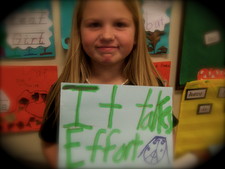Fundraiser:21st Century Learners
0 days left 04/20/2012  0%
Raised Goal: $2500.00
Raised: $0.00 ...Or, join the team and help spread the word! 1. Description of Project: The following project proposal is for a Bretford Powersync Cart with iPods and protection plans. The iPod powersyncing cart would be used to sync and charge multiple iPod devices with the MacBook all at once. The powersync cart would sync, organize and charge up to forty iPod devices at the same time. When I want to add new Apps or other content to the iPods, I can simply connect my MacBook and turn on the cart. Each iPod will be ready to begin syncing. The Powersyncing cart will also make it possible for the devices to be programmed to look the same. The benefit of this feature would be so that when I give instructions to find a particular icon, app, etc. on the device, all of my students would be able to find it in the same place on the iPod. It also provides for a time saving and well organized avenue to upload programs to the iPods rather than uploading each individual device. Finally, at the end of the day, the iPods and MacBook are safe inside the cart organized, safe and sound and charged for the next day of learning. 1. Cont. Project Objectives & Student Outcomes: ~Examples of technology integrated into rigorous curriculum~ The following is how iPods are and can be integrated into the McPherson schools: Morning Procedures: The students arrive in the classroom and go straight to the Powersyncing cart. They disconnect their assigned and numbered iPod from the syncing cart and take their iPod and earbuds to their desk. They begin by clicking on the WEATHER icon that already comes installed on the iPod upon arrival. The student finds McPherson, Kansas’ weather and temperature. They take the information and apply it by graphing the weather and filling in a thermometer each day. They also have a chance to see what the forecast for the rest of the week is. In addition to checking our area’s forecast, the students can type in any area of the world that they are studying at the time and compare the weather and temperature to other continents, countries, states, and cities. With this activity alone, I have enhanced calendar, science, math, social studies and widened my students’ view of the world. Math: The students utilize the Early Math app (free download) in order to review math vocabulary. I have the student select the common core domain that we are studying such as measurement and the app has the student move through animated flash cards of the vocabulary that go along with this domain. This same app has another section where the students apply the vocabulary that they have been reviewing, such as which is longer? The app shows two objects and the student touches the answer. When our math expert Sandy Atkins visits our district, she always reminds us that the students need more practice of quick images. The iPods are a fantastic way to differentiate quick images for student needs. Students can use the Dice app (free download) to internalize dot patterns for number sense. The app can be differentiated to roll one, two or more dice according to need. The students touch the screen or shake the iPod up and down, the dice will spin. The students are to say the number of dots they rolled before the number appears. There are many other free downloads that can be utilized for this type of practice. In fact, there are free apps available for every domain of the new Common Core Standards. There are also utility tools on the iPods such as dice, rulers, clocks, blocks, spinners and calculators just to name a few. Next comes Reading: The students have Sustained Silent Reading time each day and during this time they are voice recording their reading on the iPod device and emailing the results to parents. The record of their reading can also be saved for teacher records, student improvement meetings, parent/teacher conferences and student conferences. I have had a very positive response from families from this activity. One mother stated, “I start my days with checking email and absolutely love clicking on the email from my daughter and listening to her read to me before the day gets so hectic.” The students also have a shared reading time. This is the time of the day when all students are reading the same text. Treasures is one of our district’s resources for accomplishing this type of reading activity. I have taken all of the stories from our Treasures books and uploaded them onto the computer, and then I had to sync each iPod so that the iPods have the Treasures stories on them. This is a great way to differentiate instruction. A few students require a preview of the story and they can listen and track the words before I actually teach the lesson. Other students might require an extra amount of time with the text. Maybe they need to read it three or four times to really become fluent and comprehend the text. This would be available with the stories recorded on the iPods. This is a prime example of how having the Powersyncing cart would help to make teaching from the iPods more efficient and effective because all iPods could be placed into the cart and programmed the same all at once rather than individually. After reading the stories, the students also respond to the literature on the notes icon or the DoodleBuddy app (free download) and email it to the teacher from the iPod. For example, the students might be reading about a girl who is deaf in their Treasures book. As a teacher, I can have students go to the notes page or DoodleBuddy app and respond to a question that I pose or have them retell the story or write a summary. They also have the availability to attach a photo that represents the story in some way. After the response to literature is emailed back to me, I can project the responses on the document camera and the class can have a class conference about the assignment. In other words, we have peer editing, higher level critical thinking, read to write – write to read responses taking place in the iPod classroom. They can also click on the Sign Language app and view videos of how to learn sign language themselves. Also included in the day is modeled reading and fluency. The iPods are another avenue for reinforcing good reading. The students can have books read to them as they track the words, they can read along with the iPod while tracking and/or read the text independently. I have been able to locate hundreds of books of all readability levels available for free download on the iPod. There are also specific phonics apps that can be downloaded for those struggling or beginning readers. There are also tons of spelling and vocabulary apps available. (all free) These apps are a great resource for Tier Reading needs and resources for the multi-tier model that our buildings have implemented. Spelling: There are apps where I can build a personalized spelling list to practice the district’s Sitton Spelling words. I have been recording the spelling lessons onto the iPods without the Powersync cart and to do so I have to record the lesson onto one iPod, download it onto my laptop and then sync each individual iPod separately and then label each iPod what it is that I have added. This is where the Powersyncing cart would make teaching from the iPod much more efficient and effective. The process that I am going through would not be feasible with a larger number of iPods. After the iPods are ready for the week, then the students can take individualized spelling and/or Fundations tests from the iPods. Again, I feel that this concept of individualizing the spelling lessons for the students is beneficial to their individual learning needs. Writing: The iPods place a new spin on pen pal writing and the popular “blogging.” I have been blogging with my students for two years now and have found that this format of written communication makes print reflective and motivating to students. Now that we have discussed most of the language arts areas lets reflect upon the Language Arts Common Core Standards: Are my students asking and answering questions about text? Are my students exposed to diverse cultures? Are my students describing characters? Are my students examining the structure of text? Are my students comparing/contrasting? Do my students comprehend text? Do my students understand details? Are my students making connections? Do my students understand the meaning of words? Can my students describe main purpose? Are my students successful with word analysis? Do my students read with accuracy and fluently? Do my students write opinions, for information, explanation? Do my students write narratives? Do my students use a variety of digital tools and publish writing? Do my students know how to research? Can my students create audio recordings of stories or poems; add displays? Can my students appropriately use formal and informal language? HUM! What do you think? Does the iPod classroom implement the Common Core Standards well? Are students motivated to learn? Will they be ready for their world of technology and diversity? Science/Social Studies: During the Science and Social Studies part of our day students have the capability to watch BrainPop videos that are pertinent to our topic of study from the iPod. I have downloaded the Science House app (free) and the students can scan the list of virtual science experiments that can be viewed in video format and there are numerous apps about animals, habitats and structures of the students’ world that can be downloaded. The students can view the stars, the anatomy of the body, take a solar walk, go to Google Earth and/or Google Maps and much more. I especially like the students to work with the GeoPop app. (free) The students drag a state name card to the plotted marker on the United States map. This app is quick and easy to run but yet extremely beneficial for students to learn where the states are located on the United States map. In addition, to all the above I haven’t mentioned that the iPods are also connected to the Internet; therefore they have access to all of the district websites. The learning websites were added after teachers met this summer to work on alignment of the new Common Core Standards and our district’s curriculum. 2. Support Improvements, Core Standards: If granted, this proposal will enhance curriculum, support learning objectives and maintain the C3 (college, career, citizenship) initiative by enhancing both what and how children learn in the classroom: (1) active engagement, (2) participation in groups, (3) frequent interaction and feedback and (4) connections to real-world contexts. In addition to supporting the district’s improvement efforts, this proposal would enhance the following Common Core Standards. Writing.2.6. With guidance and support from adults, use a variety of digital tools to produce and publish writing, including in collaboration with peers. Speech/Language.2.5. Create audio recordings of stories or poems; add drawings or other visual displays to stories or recounts of experiences when appropriate to clarify ideas, thoughts, and feelings. Speech/Language L 2.1 Participate in collaborative conversations with diverse partners about Grade 2 topics and texts with peers and adults in small and larger groups Speech/Language L 2.2 Recount or describe key ideas or details from a text read aloud or information presented orally or through other media. Technology 5.2.1 ...is able to understand and enjoy creative works presented in a variety of formats, e.g., video, film, internet, television, and other creative presentations Technology. 10.1.2 ...use a variety of media and technology resources for directed and independent learning activities. Technology 10.1.3 ...communicates about technology using developmentally appropriate and accurate terminology. 3. Research: Moss (2005) observes that, since their first appearance in 2001, Apple’s range of portable digital media players (e.g. iPods) have become one of the most recognizable icons of the twenty-first century. Campuses throughout the nation are now transforming iPods into educational tools. The iPod touch is at the forefront of technology, and is a device that many students are familiar with and use on a daily basis. In a 2000 study commissioned by the Software and Information Industry Association, Sivin-Kachala and Bialo (2000) reviewed 311 research studies on the effectiveness of technology on student achievement. Their findings revealed positive and consistent patterns when students were engaged in technology-rich environments, including significant gains and achievement in all subject areas, increased achievement in preschool through high school for both regular and special needs students, and improved attitudes toward learning and increased self-esteem. According to Adenekan (2005) and Lederman (2005), the range of uses of iPods presently have given rise especially in the whole area of elearning education and innovation. A fair number of students also report using the iPods or similar devices as a way to block out distractions, especially the chatter of those who are not so concerned about working, while they are working. Students with ADD or ADHD have also been observed to become remarkably focused if they are able to have an iPod with them; it probably helps to give them control over the amount of sensory stimulation. Others also noted that iPods offer a unique and increasingly cost-effective way to differentiate instruction. They can be an effective way to take instruction home to the family and that the use of iPod in the classroom holds and heightened student interest, engages students in learning, and provides yet another means for expressive and receptive literacy. Teachers reported that students seemed more engaged in classes where they could use the iPods. Michael H. Levine, the executive director of New York City’s, Joan Ganz Cooney Center, at Sesame Workshop states, “It is no longer a question of whether we should use these devices to support learning, but how and when to use them.” “Mobile devices are part of the fabric of children’s lives today and are here to stay,” There can be little doubt that technology is very important for all students: moreover, it can be critical for students in various subgroups, such as limited-English proficiency and students with special needs (Padron & Waxman, 1996; Lee, 2000; Edyburn, Higgins & Boone, 2005). Instructional technology is generally recognized as a powerful means to boost student achievement (Kulik, 2002; Waxman, Connell & Gray, 2002). 4. Who Benefits? If accepted, this proposal will benefit classrooms, teachers, parents and the district as a whole. This project will directly benefit fifty students and five teachers. It will indirectly benefit three hundred students, twenty teachers, parents and the district itself. 5. Timeline: The timeline of the project implementation would be immediate upon arrival of the materials and ongoing from year to year. 6. Evaluation and Assessment: The benefits of this proposal will be evaluated through surveys, AIMSweb reading and math probes, project rubrics, parent evaluations and voice recordings on the iPod devices. The proof will be right there! Share This Link: http://www.digitalwish.com/dw/digitalwish/view_fundraiser?id=249
*Transaction fees apply to this amount. Spread The Word: |
||||||||




